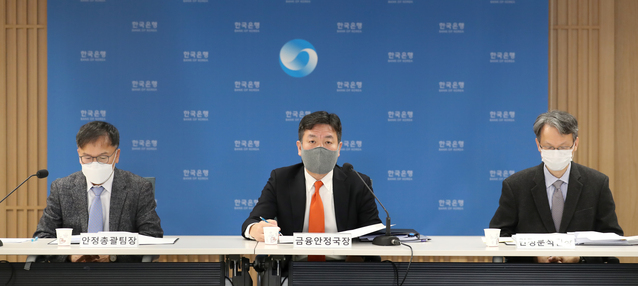Input 2020-12-24 13:48 | Revision 2020-12-24 13:48

▲ From the left, Shin Hyun-yeol, head of the Stability Management Team of the Bank of Korea, Min Jwa-hong, head of the Financial Stability Bureau, and Lee Min-gyu, head of the Stability Analysis Team, are presenting the Financial Stability Report. ⓒ The Bank of Korea
Although housing and credit loans are increasing, the rate of increase in household income is falling due to the aftermath of Corona 19. For the first time, household debt surpassed GDP. If household income is not properly improved, the risk of insolvency is a concern.
In addition, a new phenomenon emerged that the young people in 2030 are experiencing a rapid increase in household loans compared to other age groups due to increased demand for cheonsei and increased stock investment. Among the self-employed, there is a prospect that when the government’s financial support measures are terminated in March next year, the number of households who are incapable of repayment will increase rapidly.
According to the Financial Stability Report for the second half of 2020 released by the Bank of Korea on the 24th, the ratio of private credit to nominal GDP was 211.2% at the end of the third quarter, up 16.6%p from the same period last year.
Specifically, the household credit ratio was 101.1% at the end of the third quarter, an increase of 7.4%p from the same period last year, and the corporate credit ratio was also 110.1%, an increase of 9.2%p from the same period last year.
In particular, it is the first time that the household credit ratio has exceeded 100% since related statistics were compiled. This means that household debt has exceeded GDP.
The BOK said, “Housing-related loans and credit loans are increasing, and as the rate of increase in disposable income of households has decreased, the debt repayment burden has increased.”
Accordingly, the Bank of Korea pointed out that if household income conditions are poorly improved due to delayed economic recovery, etc., the risk of insolvency may increase, mainly for vulnerable households.
Household debt increased by 7.0% year-on-year to 168.21 trillion won at the end of the third quarter, and the increase has been gradually increasing since the fourth quarter of last year. This is because home mortgage loans increased 7.2%, and other loans also increased 6.8%, led by credit loans.
◇ Household loans for young people, up 8.5% year-on-year
In 2030, household loans increased sharply due to increased demand for rent to cheonsei and increased stock investment. As of the end of the third quarter of this year, household loans for young people in their 20s and 30s increased by 8.5% compared to the same period last year.
This shows a rapid increase compared to other age groups (6.5%).
The BOK said, “This is due to demand-side factors such as an increase in demand for cheonsei and housing purchases by young people, and an increase in demand for stock investment.” ”Analyzed.
However, the Bank of Korea evaluated that despite the steep rise in household loans for young people, the debt repayment burden is not yet large. This is because the ratio of repayment of principal and interest to income is falling significantly compared to other age groups. The household loan delinquency rate (0.47%) was also lower than that of other age groups (0.71%).
The Bank of Korea said, “The increase in household debt among young people is not yet a big concern, but if the rapid increase continues, the debt repayment capacity may weaken.”
◇ The proportion of self-employed people who cannot repay will increase to 2% in March next year.
When the financial support related to Corona 19 ends in March next year, the proportion of self-employed households with liquidity risk and non-repayable will increase rapidly, and it is expected that they will be difficult to recover to their previous state.
The Bank of Korea predicted that while deficit households will not increase significantly among self-employed households, liquidity risk and non-payable households will continue to increase.
It is explained that in the case of existing deficit households, the deterioration of the income and expenditure will continue despite government support.
This is a test result of a scenario that may occur when the government and financial institutions end the repayment of principal and interest for small business owners in March next year.
The BOK predicted that “the proportion of households facing both liquidity risk and non-repayment situation will also rise from 0.4% to 2%, making it difficult to recover to the previous state.”
Therefore, the Bank of Korea pointed out that it is effective to provide funding preferentially to self-employed persons facing a temporary liquidity crisis through loan review by financial institutions.
Press releases and article reports [email protected]
[자유민주·시장경제의 파수꾼 – 뉴데일리 newdaily.co.kr]
Copyrights ⓒ 2005 New Daily News-Unauthorized reproduction, redistribution prohibited
recommendation
Related Articles It’s great to read it with the article you just saw!
Vivid
Headline news Meet the main news at this time.
